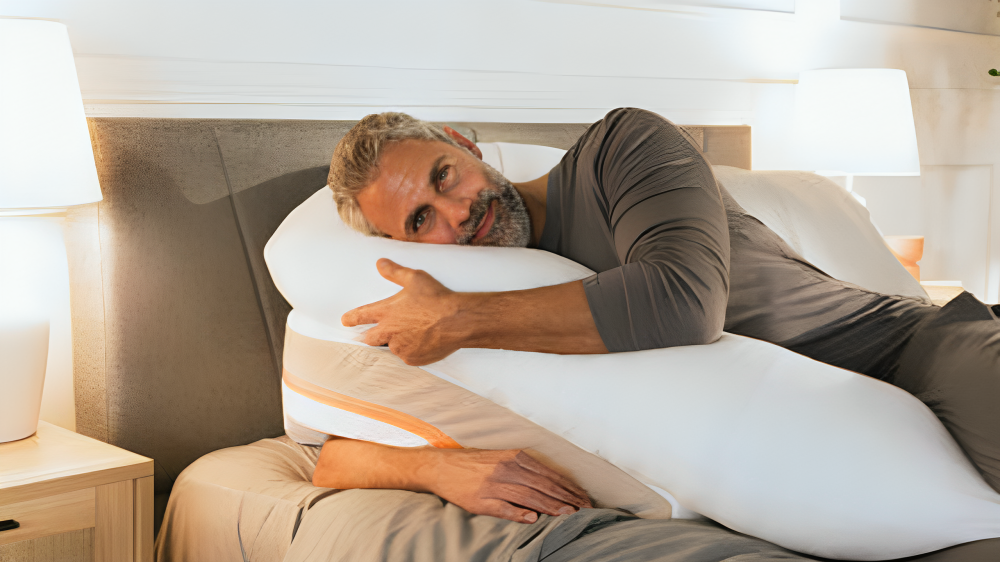Side sleepers make up a big part of the world. And a lot of them enjoy the calm of a steady shoulder and a quiet room. Yet mornings can feel stiff when the neck does not get the right support. Often, the cause hides in plain sight. It is the pillow.
A flat or squishy pillow lets the head tip. A tall, hard pillow props it up. Both choices strain small joints and tight muscles. The fix is actually not that hard to accomplish. Match pillow height to your shoulder gap. Then, pick a shape that keeps your head level.
Choose a fill that holds its form through the night. Small changes add up. When your setup fits, you sleep deeply and wake clear, with less tension and more ease in your neck. So let’s get into what makes pillows for neck pains and side sleepers great.
Why Side Sleepers Need a Different Pillow
Side sleep loads the neck and shoulder in a special way and needs tailored support. This is something which a lot of people underestimate. A pillow for neck pain side sleeper comfort should fill the space between the ear and the mattress so the neck stays straight. If that gap is empty, the head drops. If the pillow is too tall, the head tilts the other way. Either way, muscles work while you rest. That is why a side sleeper often needs more loft than a back sleeper and a build that keeps height from edge to edge.
The Rule of Alignment
Keep the spine as straight as it looks when you stand tall. On your side, picture a line from the tailbone to the base of your skull. Your pillow’s job is to hold the head so that the line stays level. Too low bends the line downward.
Too high bends it upward. In both cases, the neck pays the price. When alignment is right, the jaw feels free, the shoulder can sink without a pinch, and breathing feels smooth.
Quick alignment check
- Lie on your side in your usual sleep spot.
- Have a friend look from behind. Your nose should line up with your breastbone.
- If not, raise or lower the pillow until the line looks flat.
Loft and Firmness
Loft means height. Side sleepers often do best with a medium to high loft.
- Narrow shoulders or a softer mattress can use medium loft.
- Broader shoulders or a firmer mattress often need high loft.
Firmness keeps the pillow from going flat at 2 a.m. Aim for medium firm. If your head sinks and the neck dips, it is too soft. If your jaw feels pushed up, it is too firm. The sweet spot feels steady but not hard.
Shapes That Make Life Easier
Some builds make alignment simple and repeatable.
- Gusseted pillows have a side panel that keeps the edges tall. Height stays even across the surface.
- Cervical contour pillows use a dip for the head with higher rails under the neck. Many side sleepers like the built-in cradle.
- Adjustable-fill pillows let you remove or add fill to dial in height. Good for new beds or changing needs.
Materials: What They Feel Like
Your fill changes support, airflow, and feel. Here is a plain guide.
- Memory foam molds to you and spreads pressure. It keeps a clear shape and steady height.
- Latex feels springy and lively. It holds loft well and can sleep cooler than solid memory foam.
- Shredded foam bends and squishes into place. It breathes better and is easy to fluff.
- Down alternative is light and soft. It may need a gusset to reach side-sleeper height.
- Buckwheat hulls act like tiny beads. You can shape them, and they stay put. They feel firm and make a faint rustle.
Cooling and Breathability
Heat can wake you and cause more turning. Turning tugs on the neck. Cool sleep helps you stay still and relaxed.
Look for:
- Vent holes or channels in foam cores
- Airy covers made of cotton, bamboo-viscose blends, or soft knits
- Phase-change fabrics that feel cool to the touch
- Shredded fills that allow airflow
Keep the cover clean so fibers wick well. Fresh fabric stays smoother on the cheek and jaw.
Conclusion
Good sleep for a side sleeper starts with smart support, not luck. Focus on three simple wins. Keep the neck level with your spine. Fill the shoulder gap so the head does not tilt. Choose a fill that keeps its height through the night and a cover that breathes. Measure your shoulder gap once and use it to guide loft.
Try a shape that makes alignment easy to repeat, like a steady gusset or a gentle contour. Do a short home test and listen to your body the next morning. When the fit is right, you wake clear and loose, ready to move. A few careful choices today can make every night softer on your neck.

